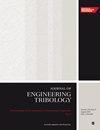Tribological roles of MoS2 and PTFE nano oils at the rolling/sliding point contacts: Conventional versus textured contacts
IF 1.8
3区 工程技术
Q3 ENGINEERING, MECHANICAL
Proceedings of the Institution of Mechanical Engineers, Part J: Journal of Engineering Tribology
Pub Date : 2023-03-15
DOI:10.1177/13506501231161475
引用次数: 0
Abstract
Nanolubricants and surface textures have evidenced the ability to improve the tribo-performances of concentrated contacts. Motivated by this finding as reported in the literature, in the present work, the synergistic uses of laser-created surface textures and nanolubricants have been employed to explore and improve the tribological behaviours of moderately loaded (PH = 0.5 and 0.8 GPa) point contacts operating mainly in mixed and elastohydrodynamic lubrication regimes. MoS2 and polytetrafluoroethylene (PTFE) nanoparticles based on two nanolubricants were prepared in the laboratory to lubricate the rolling/sliding conventional and textured point contacts. Two sets of contacts (grounded discs versus lapped balls and grounded textured discs versus lapped balls) have been employed to create the geometric configuration of conventional and textured concentrated point contacts. Based on the experimental results found herein, the friction coefficient with the textured contacts reduced by 64% in the presence of MoS2-based nanolubricant as compared to the conventional point contact lubricated with the base oil; however, in the presence of polytetrafluoroethylene-based nanolubricant, this reduction has been recorded by 56%. The textured surface involving a small dimple size yielded better results than the relatively large size. Worn surfaces have been investigated and analysed using optical and scanning electron microscopy/energy dispersive X-ray spectroscopy micro-images. Moreover, certain surface studies using atomic force microscope have also been conducted to understand the surface topography and associated wear mechanisms.二硫化钼和聚四氟乙烯纳米油在滚动/滑动点接触中的摩擦学作用:常规接触与纹理接触
纳米润滑剂和表面织构已被证明能够改善集中接触的摩擦性能。在文献报道的这一发现的推动下,在本研究中,激光产生的表面纹理和纳米润滑剂的协同使用被用于探索和改善中等负载(PH = 0.5和0.8 GPa)点接触的摩擦学行为,主要是在混合和弹性流体动力润滑制度下运行。在实验室中制备了基于两种纳米润滑剂的二硫化钼和聚四氟乙烯(PTFE)纳米颗粒,以润滑滚动/滑动的常规点触点和纹理点触点。采用两组触点(接地盘与搭接球和接地纹理盘与搭接球)来创建常规和纹理集中点触点的几何结构。实验结果表明,与使用基础油润滑的传统点接触相比,在mos2基纳米润滑剂的存在下,织构接触的摩擦系数降低了64%;然而,在聚四氟乙烯基纳米润滑剂的存在下,这一降幅达到56%。涉及小酒窝尺寸的纹理表面比相对较大的尺寸产生更好的结果。使用光学和扫描电子显微镜/能量色散x射线光谱显微图像对磨损表面进行了研究和分析。此外,还使用原子力显微镜进行了一些表面研究,以了解表面形貌和相关的磨损机制。
本文章由计算机程序翻译,如有差异,请以英文原文为准。
求助全文
约1分钟内获得全文
求助全文
来源期刊

CiteScore
4.20
自引率
5.00%
发文量
110
审稿时长
6.1 months
期刊介绍:
The Journal of Engineering Tribology publishes high-quality, peer-reviewed papers from academia and industry worldwide on the engineering science associated with tribology and its applications.
"I am proud to say that I have been part of the tribology research community for almost 20 years. That community has always seemed to me to be highly active, progressive, and closely knit. The conferences are well attended and are characterised by a warmth and friendliness that transcends national boundaries. I see Part J as being an important part of that community, giving us an outlet to publish and promote our scholarly activities. I very much look forward to my term of office as editor of your Journal. I hope you will continue to submit papers, help out with reviewing, and most importantly to read and talk about the work you will find there." Professor Rob Dwyer-Joyce, Sheffield University, UK
This journal is a member of the Committee on Publication Ethics (COPE).
 求助内容:
求助内容: 应助结果提醒方式:
应助结果提醒方式:


